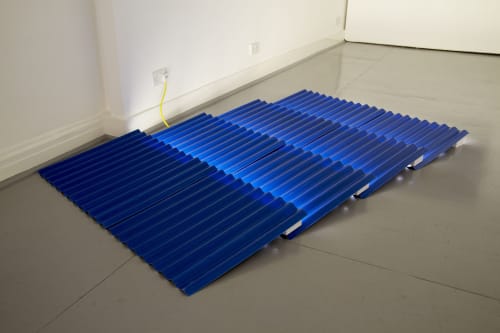UNSEEN: SUMMER GROUP EXHIBITION
For the final exhibition of the season Lawrie Shabibi presents UNSEEN, a group show of recent works by artists from the gallery roster: Adel Abidin, Farhad Ahrarnia, Asad Faulwell, Driss Ouadahi, Nathaniel Rackowe and Shahpour Pouyan. The show continues until 10 September, 2016.
In Michael Adel Abidin imagines a resurrection of Michael Jackson – one of the universally celebrated pop icons of our time - where Jackson is interviewed on a popular talk show. Resurrected from the dead Michael Jackson is treated like a prophetic figure who has returned to unveil universal truths about the world before thousands of fans who have gathered in Times Square. Michael Jackson (with no authority or accountability other than his cult status) provides answers to questions on existential topics such as the mysteries of death, afterlife and immortality to an impressionable audience.
Ahrarnia on the other hand presents new works from his khatam series (an Iranian micro-mosaic used decoratively to embellish domestic objects). As in his previous pictorial series, Ahrarnia references such qualities of the Russian Avant-Garde who greatly influenced the art and architecture of mid 20th century Iran, a cultural extension of the 19th century “Great Game”. Ahrarnia’s three khatam works presented are based on the sparse compositions of Malevich, combing an aesthetic tradition to seminal 20th century Modernist works.
Pouyan’s presentation of 39 drawings symbiotically explores ideas of human preservation and perception of images. Pouyan was fascinated by the extraordinary shape of the tomb of the 11th century Muqarnas dome of Sharaf ad-Dawla, a Shi’ite mausoleum near Mosul, Iraq recently destroyed by ISIS. Prior to its destruction in October 2014 Pouyan had kept an image of it pinned to his studio wall, hoping that he would one day visit it. Devastated by the news of its destruction and the realization that he would never see a monument of this type, he devised a way to preserve the image. Each week he would make a drawing of the tomb from memory, emphasizing the details of the Muqarnas structure, form and ornamentation, with no recourse to the original image or his previous drawings. As his memories developed the drawings became a personal documentation of the human mind’s inability to accurately document. Pouyan’s allusion to the practices of oral history, the drawings of ancient explorers, and the processes by which an experience changes and evolves over time in our minds closely corresponds to the cross-fertilisation of ideas and images across borders prevalent to the Islamic world and Western Asia.
Yazan Khalili presents earlier photographic works from his Colour Correction and Areas A, B and C series. Central themes in Khalili’s work are the trauma of losing the homeland in 1948, the sense of separation between the shared memories of the older, exiled generation and the present reality of Palestine. Sansour on the other hand confronts the Palestine question by looking to science fiction and dystopian fictional narratives, presenting a work from her critically acclaimed Nation Estate series.
Faulwell presents works from his ongoing series entitled Les Femmes D'Alger, an homage to the forgotten Algerian women who fought alongside their male counterparts in the war of independence from French occupation between 1954 - 1962. His works are intricately produced and involve poetic collaged paintings of these unique women based on photographs taken during their lifetimes. The repetition of images and the quasi-religious imagery he employs give the series the air of devotional shrines whilst the brightly coloured, elaborate, repetitive arrangements are reminiscent both of Henri Matisse's decorative patterning as well as Faulwell's own Iranian tradition of geometric design.
Finally, Ouadahi and Rackowe continue their preoccupation with urban environments: Ouadahi through paintings of urban structures that share a dreamlike perspective blurring between reality and the artist’s imagination and in the case of Rackowe through a sculpture that mixes construction materials with neon lights along the gallery’s floor.








